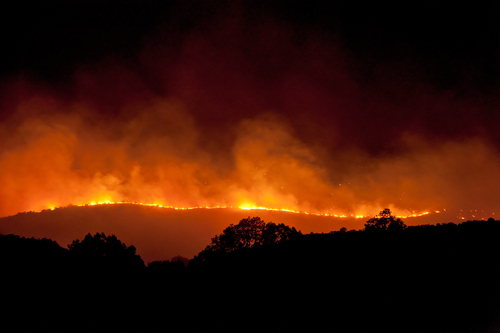The loss estimate utilized RMS’ forthcoming North America Wildfire High Definition (HD) Model to simulate the ignition, fire spread, ember accumulations, and smoke dispersion of the fires. The model’s findings were supported by damage reports from CAL FIRE as of November 18th, observations from displaced residents, and information from firefighting personnel.
The Camp and Woolsey events were among 15 fires that broke out in early November, 2018. The Camp and Woolsey Fires have currently burned a combined total of 245,000 acres, destroyed more than 12,000 homes and businesses, and killed 80 people. The Camp Fire, named for the road of its point of origin, is the most destructive fire in California history, with more than 11,000 structures burned and currently 77 fatalities. Notably, this fire season represents the second consecutive year with more than $10 billion in insured wildfire loss.
While the fuel landscape between the two fires differs significantly, with heavy forestry characterizing the Camp Fire (Northern California) and shrubland in the Woolsey Fire (Southern California), both developed under dangerous conditions that favor quick fire spread: low moisture, abnormally high temperatures, dry vegetation, and intense seasonal winds. Both traveled quickly through steep, hilly, vegetated terrain.
The town of Paradise, CA, which suffered the worst losses of the Camp Fire, has narrowly avoided catastrophic wildfires many times over the past 20 years. Thirteen large fires since 1999 have burned inside the current footprint of the Camp Fire.
The Woolsey Fire, igniting in Ventura County and jumping the Highway 101 before spreading to Malibu, resulted in over 250,000 evacuations and burned more than 1,450 high value properties.
The area around the Woolsey Fire shares a similar, if less stark, history of frequent fires. Six large fires since 1999 intersect the Woolsey footprint. Going back to 1993, the Old Topanga Wildfire, which caused almost $1 billion in today’s dollars, occurred immediately next where the Woolsey fire is currently burning.
Mohsen Rahnama, Chief Risk Modeling Officer, RMS, said: “Wildfire is now a major catastrophe risk that must be rigorously managed with the best data and model science. With increasing exposure due to properties near wildland areas and ongoing climate variability, insurers, policymakers, and homeowners must adapt to the prospect of more frequent and severe wildfires.”
“In the wake of consecutive record-breaking wildfire seasons, we are hopeful that more focus will be placed on fire mitigation, safe construction practices, and community resilience. The forthcoming RMS HD Wildfire model, developed in partnership with leading insurers and fire experts, represents a step change in measuring wildfire risk, with a 50,000-year climate simulation, explicit ember and smoke simulations, and a vulnerability module calibrated on hundreds of millions of dollars of claims data. We are confident the model will contribute to the creation of safer communities that promote fire safety and awareness.”
About RMS
RMS solutions help insurers, financial markets, corporations, and public agencies evaluate and manage catastrophe risks throughout the world. RMS has over 1,200 employees across 13 offices in the US, London, Bermuda, Zurich, India, China, Japan, Singapore and Australia - our products and models covering six continents.
We lead an industry that we helped to pioneer—catastrophe risk modeling—and are delivering models, data, and risk management solutions on the RMS(one)® platform to transform the world’s understanding and quantification of risk through open, real-time exposure and risk management.
More than 400 insurers, reinsurers, trading companies, and other financial institutions trust RMS solutions to better understand and manage the risks of natural and human-made catastrophes, including hurricanes, earthquakes, floods, terrorism, and pandemics.













